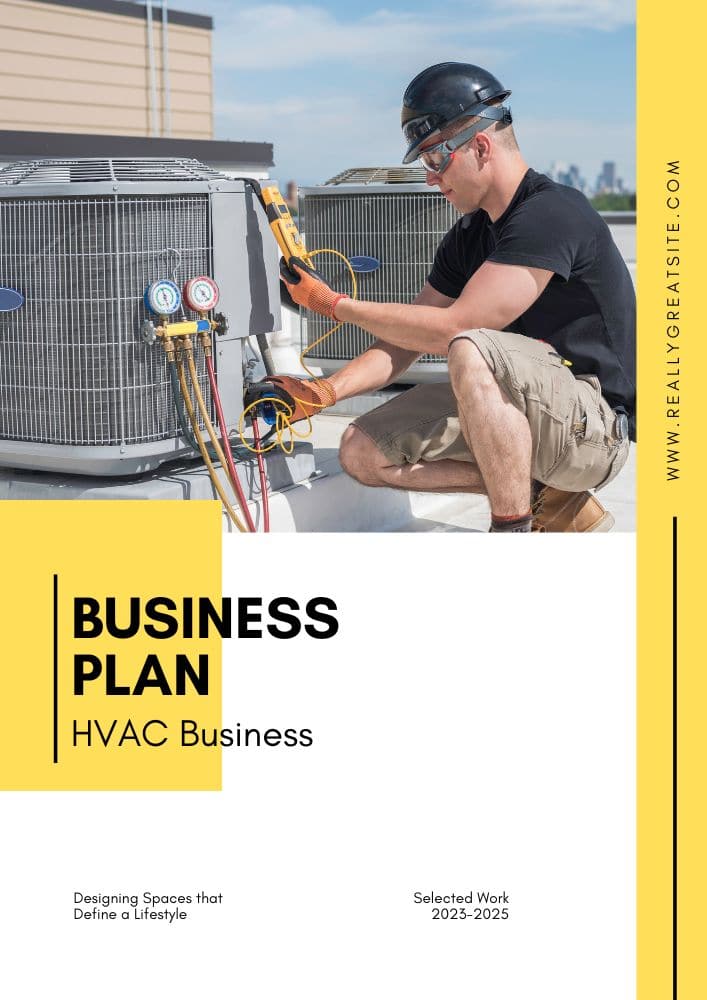Written by Elma Steven | Updated on June, 2024

How Do I Write the HVAC Business Plan?
HVAC Business Plan is an outline of your overall HVAC business. The business plan should includes a 5 year financial projection, marketing plan, industry analysis, organizational overview, operational overview and finally an executive summary. Remember to write your executive summary at the end as it is considered as a snapshot of the overall business plan. You need to be careful while writing the plan as you need to consider various factors that can impact the business’s success.
Table of Contents
Executive Summary
Climate Control Solutions was founded by HVAC industry veteran Michael Torres is one of the best companies of its kind in Miami. Our company is dedicated to serving both business and residential customers with the highest standards of HVAC servicing. Every aspect of heating, ventilation and air conditioning is covered by our company. Michael and his colleagues have been working in HVAC for over 15 years so they always know just what to do.
The major characteristics of Climate Control Solutions are our cutting-edge HVAC technology a staff of highly qualified and certified experts and our dedication to energy efficiency and eco-friendly practices. We’ve made a name for ourselves in the Miami HVAC industry because to our prompt responses, dependable service and ability to tailor our services to each individual client’s requirements.
Mission: Our mission is to give Miami residents and businesses with the best grade of HVAC services. We prioritize establishing long-lasting connections with our customers by providing them with pleasant, healthy and energy-efficient interior spaces.
Vision: Our vision is to be the go-to HVAC company for our cutting-edge solutions, stellar customer service and commitment to promoting a greener way of life. Strive to be the top option renowned for improving the industry standards and encouraging environmental responsibility.
Industry Overview:
The heating, ventilation and air conditioning (HVAC) business is valued USD 234.94 billion by 2030. This includes the design, production, installation and repair of HVAC systems across the world. Rising demand for HVAC systems that are also energy efficient, increased urbanization and a focus on creating and sustaining pleasant and healthy indoor environments all contribute to this expansion.
Check out this guide on how to write an executive summary? If you don’t have the time to write on then you can use this custom Executive Summary Writer to save Hrs. of your precious time.
Financial Highlights:
Revenue & Earnings

Cost of Goods Sold & Expenses

Break- Even Analysis

Investments or Fund Usage Plan

Business Description
Business Name: Climate Control Solutions
Founders: Michael Torres
Management Team:

Legal Structure: LLC
Location: Miami
Goals & Objectives:
✔️Revenue Growth: Focusing on both the residential and commercial segments can help you achieve your revenue goals.
✔️Service Area Expansion: In the next years you should make plans to increase the number of areas you serve.
✔️Customer Satisfaction Enhancement: Enhance client satisfaction by educating employees on cutting-edge HVAC equipment and servicing techniques.
✔️Maintenance and Service Program Development: Build a strong maintenance and service program to secure long-term patronage from satisfied customers.
✔️Aggressive Marketing Strategy: Use social media, local advertising and collaborations with construction companies to expand your consumer base and exposure.
Services:
✔️Residential HVAC Services: Provide full service heating, cooling and ventilation for houses by installing, repairing and maintaining HVAC units. This category might also cover energy efficiency assessments and renovations for residential homes.
✔️Commercial HVAC Services: Offer specialized HVAC services for business settings like offices, stores and factories. This covers large-scale installations, maintenance contracts and system modifications for energy efficiency.
✔️Emergency Repair Services: Maintain a timely response time for both business and residential customers in the event of an emergency. Providing this service to your customers may be a huge selling factor showing them that you care about their satisfaction.
✔️HVAC System Design and Consultation: Provide professional advice and design for building projects of all kinds. Adapting heating, ventilation and air conditioning (HVAC) systems to suit unique requirements is part of this process.
✔️Indoor Air Quality Solutions: Place special emphasis on enhancing indoor air quality via the use of humidifiers, dehumidifiers and air purifiers and the provision of routine maintenance services for these devices.
Business Model
Check out 100 samples of business model canvas.
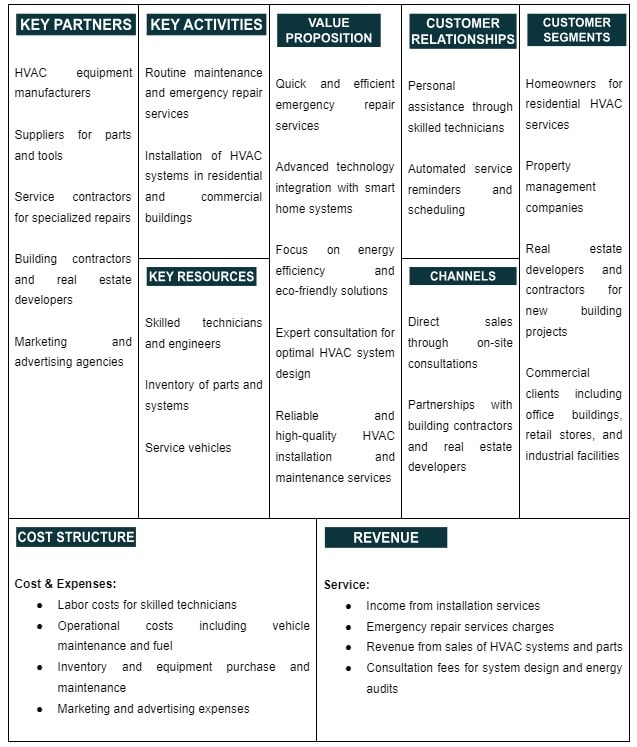
SWOT
Check out the 100 SWOT samples which will give you a better idea on SWOT writing process.

Marketing Plan
The marketing plan has five main sections. These sections are marketing budget, marketing channels, GTM or Go To Market Strategy and brand management. The marketing budget will explain how much you plan to spend on promotions and what will be the proportion of spending across the channels. The marketing channels section will talk about how you plan to use each of the promotional channels. The GTM strategy can be considered as the short term version of promotional channels section where you explain how you plan to penetrate the market using the channels at the beginning. Finally, brand management is the longer term version of the promotional channels section where you explain how you plan to enhance brand awareness, recognition and brand recalls amongst your target market.
Promotional Channels
Social Media and Online Marketing – $15,000 (30%)
✔️Platform Focus: Take advantage of the large number of potential customers and precise targeting offered by social media sites like Facebook, Instagram and LinkedIn. Showcase your HVAC business’s expertise by posting before-and-after images of completed projects, client feedback and helpful upkeep tips.
✔️Paid Ads: Spend money on advertising that will reach people who own homes, manage properties and own businesses. Leverage the platform’s technology for targeting based on demographics, property characteristics and other factors.
✔️Content Strategy: Regular updates showcasing your offerings, seasonal upkeep advice and limited-time discounts. Engage your audience in the moment by sharing live videos or tales.
Website Development and SEO – $10,000 (20%)
✔️Website Overhaul: Ensure your website is user-friendly, mobile-responsive and highlights your services, customer testimonials and contact information.
✔️Blog Content: Regularly maintain a blog with material on HVAC maintenance recommendations, energy efficiency and industry updates to interest visitors and enhance SEO.
✔️SEO Optimization: Focus on keywords related to HVAC services, energy efficiency and local areas served to enhance online visibility and search rankings.
Email Marketing – $7,500 (15%)
✔️Newsletter Campaigns: Make a newsletter with updates, maintenance advice, sales and other corporate information once a month.
✔️Customer Segmentation: Tailor content for different segments such as residential clients, commercial clients and potential customers.
Local Community Engagement – $6,000 (12%)
✔️Local Events: Participate in community activities, house exhibitions and trade fairs. Underwrite regional athletic teams or charity functions.
✔️Partnerships: Collaborate with local businesses and realtors to offer exclusive services or bundled offers.
Direct Mail Campaigns – $5,500 (11%)
✔️Targeted Mailers: Distribute seasonal service reminders, advertising fliers and coupon codes to certain sections of town.
✔️Branding Material: Include brochures or magnets with your contact information and services offered.
Referral and Loyalty Programs – $4,000 (8%)
✔️Referral Incentives: Implement a program giving discounts or service improvements to clients who suggest new consumers.
✔️Loyalty Rewards: Develop a customer retention strategy that includes regular promotions, preferential booking and routine service checks.
Paid Local Advertising – $2,000 (4%)
✔️Local Media: Commit spend on newspaper and radio adverts and community magazine spreads.
✔️Billboards and Local Signage: Utilize billboards or local signage in high-traffic areas to increase brand visibility.
Brand Management
Social Media Marketing
✔️Brand Voice and Visual Identity: Create a brand that appeals to home and business owners by highlighting your knowledge, experience and commitment to providing excellent service. Make sure all of social media posts look the same by showcasing staff in action with tools and finished projects.
✔️User-Generated Content: Encourage pleased consumers to share their experiences and tag your company. Make use of these testimonies on your various platforms.
✔️Educational Content: Share tips on HVAC maintenance, energy efficiency and seasonal preparation to position yourself as an industry expert.
Search Engine Marketing (SEM) and Local SEO
✔️Ad Copy: Craft ad copy highlighting your unique services like energy-efficient HVAC solutions, emergency repairs or custom installations.
✔️Website Optimization: Use search engine optimization (SEO) best practices by include keywords like “HVAC services,” “air conditioning repair” and “heating solutions” on your user-friendly website.
✔️Google My Business: The more up-to-date the information is on Google My Business the higher it will rank in local search results.
Email Marketing
✔️Newsletter: Use newsletters to provide seasonal upkeep advice, discounts and summaries of recent work and customer feedback.
✔️Segmentation: Create separate email campaigns for home customers, business customers and potential new customers.
Local Partnerships and Sponsorships:
✔️Community Events: Participate in or sponsor local events to increase brand visibility.
✔️Partnerships with Real Estate Agents: Collaborate with local realtors to provide HVAC inspections and maintenance to prospective buyers.
Content Marketing
✔️Informative Blog Posts: Write blog content regarding HVAC maintenance, current technology in heating, cooling and strategies to enhance home energy efficiency.
✔️Video Tutorials: Create basic DIY HVAC maintenance video lessons or explainers on how HVAC systems function.
Go To Market Strategy
Online Presence and Community Engagement
✔️Professional Website:Create a website that highlights your HVAC services, your team’s experience and customer recommendations. Add conveniences like service descriptions and online appointment scheduling.
✔️Content Marketing: Publish useful blog content on subjects like energy efficiency, HVAC maintenance and cutting-edge HVAC technology to boost your search engine results and provide value for your viewers.
✔️Local Directory Listings: Ensure your business is listed on local online directories and home service portals to increase visibility.
✔️Community Partnerships: Offer discounts and take part in neighborhood activities by teaming up with other nearby establishments and HOAs/community organizations.
Promotional Offers and Events
✔️Seasonal Promotions: Promote seasonal services such as AC inspections before summer or heater tune-ups before winter.
✔️Open House Event: Offer free HVAC inspections and advice during a special event hosted at your place of business. An excellent chance to meet prospective clients face to face.
Digital Marketing and Customer Relations
✔️Social Media Engagement: Post HVAC maintenance advice, customer success stories and sales announcements on social media sites.
✔️Email Marketing: Make a newsletter that you can send out on a regular basis and use it to inform them about sales, new offerings and seasonal HVAC recommendations.
✔️Loyalty Program: Implement a rewards program for repeat customers, offering discounts, free annual check-ups or referral bonuses.
Brand Awareness and Public Relations
✔️Local Media Engagement: Promote your business and community participation with ads and feature stories in regional print and broadcast media.
✔️Community Sponsorships: Sponsoring local sports teams, schools and festivals is a great way to get your name out there.
✔️Influencer Collaborations: Partner with local influencers especially those focused on home improvement or lifestyle to reach a broader audience.
Performance Tracking
✔️Analytics Monitoring: Make use of analytics software like Google Analytics to monitor the success of your digital marketing initiatives.
✔️Feedback and Adaptation: Solicit input from customers on a regular basis via surveys or direct contact and be prepared to adjust your strategy in light of the results and the state of the market.
Organizational Overview
The organizational overview section summarizes the company’s structure and operations. It explains the organizational structure including the hierarchy of reporting relationships, ownership and responsibilities of key management personnel. This also explains how the founder’s past experiences and credentials can help make the business successful.
Founder

Michael Torres is the driving force behind Climate Control Solutions and a promising new HVAC startup primed to make ripples in Miami’s competitive market. His path into the HVAC sector is driven by his technical knowledge, business savvy and dedication to providing exceptional customer service.
Michael has always had a strong interest in HVAC technology and this interest prompted him to become certified and trained in the field at an early stage in his career. Michael has deep grasp of the technical and practical elements of HVAC services because to his solid educational basis and extensive field experience.
Michael has gained extensive knowledge of HVAC best practices and customer service norms from his years of experience working for a variety of organizations in the field. Having worked with both residential and business customers and now has a deeper grasp of their individual HVAC demands. A true mark of his experience is the speed and accuracy with which he diagnoses and fixes difficult problems with temperature control.
Positions and Responsibilities
Chief Executive Officer (CEO) – Michael Torres
In charge of the company’s big-picture strategy and operations. He ensures that management and operational teams are communicating effectively establishes long-term objectives and represents the company in industry interactions.
Operations Manager
This involves taking care of things like overseeing field operations and client satisfaction while also managing the service schedule. They communicate with the team to ensure that services are provided quickly and efficiently.
HVAC Technicians
Services rely heavily on HVAC technicians who are the backbone of the industry. They put up, maintain and fix air conditioning and heating units in homes and businesses. Their position calls for someone with superior technical knowledge and customer service abilities.
Health and Safety Officer
The Health and Safety Officer is responsible for ensuring that all business practices are safe and legal. They have to come up with health and safety policies and procedures carry out risk assessments and teach employees on how to follow them.
Marketing and Sales Coordinator
Promotes the company by creating and executing marketing and sales plans. In this role you will supervise advertising activities, manage digital marketing initiatives and look for ways to expand your company’s reach.
Organogram
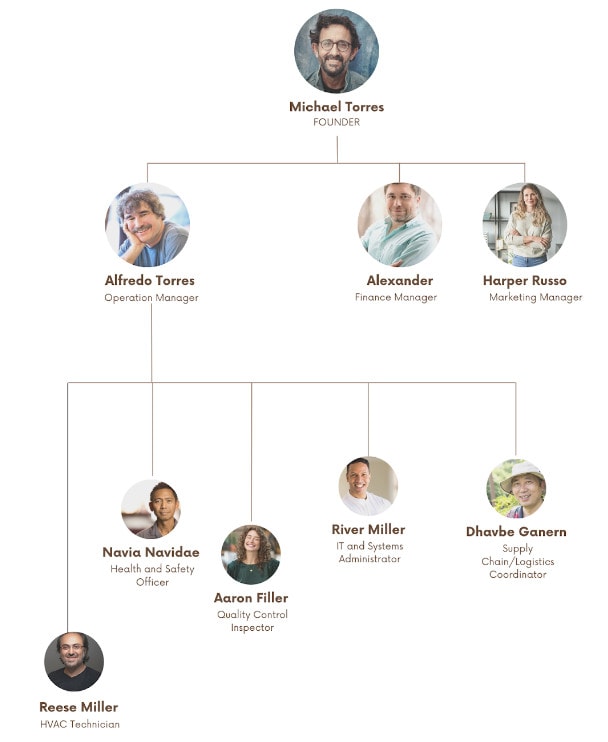
Operational Overview
Services
Residential HVAC Services
✔️Specialized in installing, maintaining and repairing HVAC systems for houses. To provide a pleasant atmosphere for households, these systems include air conditioners, furnaces, heat pumps and more.
Commercial HVAC Solutions
✔️Services for heating, ventilating and air conditioning in commercial buildings such offices, stores and factories. Installations of any size, regular maintenance and enhancements to increase efficiency are all part of the service offering.
Emergency Repair Services
✔️Offering prompt and reliable emergency repair services for unexpected breakdowns. Available 24/7 this service is crucial for immediate needs, minimizing discomfort and potential damage.
HVAC System Installation
✔️Expert installation of new HVAC systems with a focus on energy efficiency and reliability. Includes consultation to determine the best system for the client’s specific requirements.
Routine Maintenance and Tune-ups
✔️Heating, ventilation and air conditioning (HVAC) systems need regular maintenance to keep running well. This includes yearly tune-ups, filter replacements and system inspections to extend the longevity of HVAC equipment.
Industry Analysis
Commercial and residential buildings alike rely heavily on the HVAC sector to provide a pleasant and healthy interior environment for its occupants. Expanding rapidly in the United States and across the world due to a number of causes including pleasant weather, aging infrastructure and rising populations.
The US HVAC market is expected to reach a staggering value of $160 billion (marketsandmarkets) by 2028 driven by several key factors:
✔️Diverse Climate: There is year-round need for heating, ventilation and air conditioning (HVAC) systems in the United States because of the country’s varied climate.
✔️Aging Infrastructure: There is a sizable market for HVAC contractors and service providers in the United States because to the frequent upkeep, upgrades and replacements needed for the country’s aging HVAC system.
✔️Population Growth and Urbanization: Rising urbanization and a continually expanding population in the United States are driving up demand for heating, ventilation and air conditioning (HVAC) products and services.
Key Statistics and Growth Projections for the US HVAC Market:
✔️Average annual expenditure on HVAC services in the US: $250 per household
✔️Projected growth rate of the US HVAC market: 3.5% between 2023 and 2028
✔️Expected job creation in the US HVAC industry: Over 1 million by 2028
The global HVAC market is projected to reach a massive value of $367.5 billion by 2030, driven by several global trends:
✔️Urbanization and Population Growth: Demand for heating, ventilation and air conditioning (HVAC) systems to offer thermal comfort and enhance indoor air quality is on the rise as cities and their inhabitants multiply rapidly especially in developing nations (sisinternational).
✔️Rising Living Standards: As middle classes expand and living standards rise more people in emerging markets are able to afford HVAC systems for their homes and businesses.
✔️Indoor Air Quality Concerns: Growing awareness of the importance of indoor air quality and the associated health benefits are driving demand for HVAC systems that provide cleaner and healthier indoor environments.
Key Statistics and Growth Projections for the Global HVAC Market:
✔️Expected global HVAC market size: 151.1 million units by 2024 (grandviewresearch).
✔️Largest HVAC market region: Asia-Pacific accounting for over 50% of the global market share
✔️Second and third largest HVAC markets: United States and China, respectively
Industry Problems
✔️Scheduling Conflicts: Due to overbooking or a lack of technicians, customers may have trouble scheduling services at appropriate times or they may have to wait longer than expected for appointments.
✔️Service Delays: Customers might be irritated by service delays such technicians that don’t show up on time or take longer than planned to fix problems.
✔️Quality of Repair or Installation: Customers may have problems with the quality of installation or repair work such as incorrect installation, insufficient repairs or a recurrence of the same issue soon after service has been provided.
✔️Technical Misunderstandings: Customers who lack a thorough grounding in HVAC technology may find themselves confused about the nature of the services they need or the progress being made on their behalf.
✔️Cost Transparency: Issues with billing or a lack of clear upfront pricing can lead to customer dissatisfaction. Unexpected costs or feeling overcharged can be significant concerns.
Industry Opportunities
✔️Optimized Scheduling System: To better manage bookings and minimize disruptions use sophisticated scheduling software or a system. Customers may appreciate it if appointments can be made online.
✔️Streamlining Service Delivery: Implementing GPS tracking for faster technician deployment and providing accurate time estimates for repairs and installs are just two examples of how a well-organized system may guarantee timely service.
✔️Quality Assurance Programs: To guarantee excellent quality in installation and maintenance work, institute stringent quality control methods and provide professionals with consistent training. Offering a satisfaction guarantee may help develop client confidence.
✔️Educational Resources for Customers: Create informative content like brochures, blog posts or videos explaining HVAC services and maintenance tips, helping customers make informed decisions.
✔️Transparent Pricing Model: Implement clear upfront pricing with thorough estimates to eliminate billing surprises. You might provide financing or other payment plans for bigger jobs.
Target Market Segmentation
Geographic Segmentation
✔️Miami-Dade County Residents: Focus on the broad residential market within the county catering to homeowners with diverse HVAC needs.
✔️Specific Miami Neighborhoods: Target communities recognized for certain climatic demands or housing styles such the high-rise apartments of Downtown Miami or the vast mansions in Coral Gables.
Demographic Segmentation
✔️Age Groups: Recognize that customers of varying ages will have varying HVAC requirements and preferences and cater your services accordingly.
✔️Income Levels: Create a spectrum of HVAC offerings from basic maintenance for those on a tighter budget to deluxe energy-saving setups for those with more disposable income.
✔️Family Size and Structure: Cater to different family sizes and structures recognizing that larger families or multi-generational homes may have unique heating and cooling needs.
Psychographic Segmentation
✔️Eco-conscious Consumers: Target customers interested in sustainable and energy-efficient HVAC solutions.
✔️Tech-Savvy Homeowners: Pay close attention to the customers who would benefit most from having their HVAC and smart home systems integrated.
✔️Comfort-Seeking Customers: Some clients put a premium on convenience and are prepared to pay more for cutting-edge temperature control technology.
Behavioral Segmentation
✔️Regular Maintenance Clients: Target clients who want continuous service contracts and are aware of the significance of routine HVAC maintenance.
✔️Emergency Service Seekers: There is a market for emergency HVAC repair services since some customers need rapid help when their systems fail.
✔️Upgrade-Oriented Customers: Target homeowners or businesses looking to upgrade to newer more efficient HVAC systems.
Market Size
✔️Total Addressable Market (TAM) for Your Business: The total addressable market (TAM) is the whole worldwide market for your company’s goods and services. All people who could be interested in buying what you’re selling fall under this umbrella. TAM covers a large area, allowing for maximum market penetration. Global industry developments, new technologies and changing customer preferences may all play a role in determining the TAM. By looking at the market at large, we may see its potential maximum size, however this is an ideal rather than a realistic goal.
✔️Serviceable Addressable Market (SAM) for Your Business: By reducing the total addressable market (TAM) to a manageable subset, company can better concentrate its resources. These are people who are within driving distance of your business who fit a given demographic profile or whose requirements are well served by the products or services you provide. The SAM may be defined by the geography of your company, the specificity of its goods and services and its routes of distribution. It’s a more specific subset of consumers representing a more manageable chunk of the market for your company to conquer.
✔️Serviceable Obtainable Market (SOM) for Your Business: The SOM is a subset of SAM that your company may realistically hope to capture in the near to intermediate future. Your present market share, the nature of your competition, the strength of your operations and the efficiency of your advertising will all play a role. If you want to know how much of the market your company may expect to capture in the near future, look no further than the SOM category. Brand recognition, client retention, operational efficiency and sales and marketing prowess all play a role.
Industry Forces
Market Demand and HVAC Trends
Due to the city’s hot and humid environment, there is a thriving market for heating, ventilation and air conditioning (HVAC) systems in Miami. Energy- and environmentally-efficient HVAC systems, smart home integration and a heightened awareness of the need of good indoor air quality are all on the rise. Increasing number of consumers are concerned about their impact on the environment and you can capitalize on this trend by providing them with innovative, energy-saving HVAC solutions, smart HVAC technology and services that boost indoor air quality.
Competition
Competition for your HVAC company comes from a variety of sources including smaller regional businesses, bigger national chains and manufacturers who supply direct installation. Superior customer care, affordable prices, niche offerings and speedy responses will set your company apart from the competition. Building a reputation for dependability and exceptional service can help you stand out in the competitive Miami market.
Technological Advances
Keeping up with technical developments is essential. Incorporating smart home technology and upgrading to more energy-efficient HVAC systems are two examples. Tech-savvy clients and those trying to save expenses in other areas will appreciate the availability of cutting-edge options like programmable thermostats, Internet of Things-enabled monitoring and energy-efficient equipment.
Regulatory Environment
It is essential that your HVAC company abides by all applicable local construction laws, environmental regulations and safety requirements. Services may always be compliant and up-to-date if you keep up with the latest rules especially those pertaining to environmental impact and energy efficiency.
Economic Factors
The capacity of Miami residents and companies to purchase new HVAC units or replace older models is hampered by the local economy. During recessions, businesses may delay or cancel renovations that aren’t absolutely necessary but during times of economic expansion the HVAC services may be a priority. Recognizing these economic trends may aid in making informed business decisions.
Financial Statements
The financial model has all the important financial statements including Income Statement, Balance Sheet and Cash Flow Statement. In addition, the financial model includes 3 to 5 years of projections and can be edited using Microsoft Excel or Google Sheets.
Income Statement
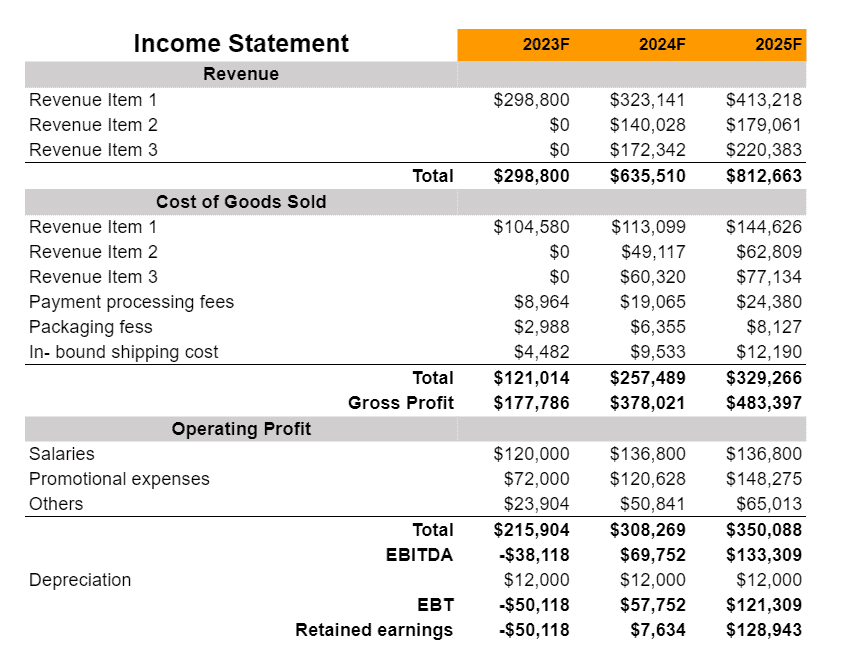
Cash Flow Statement
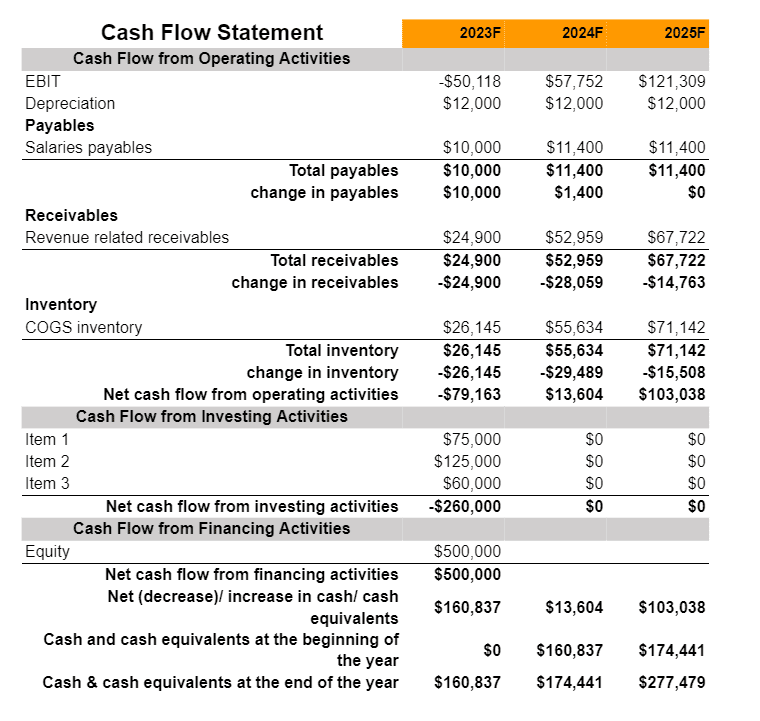
Balance Sheet
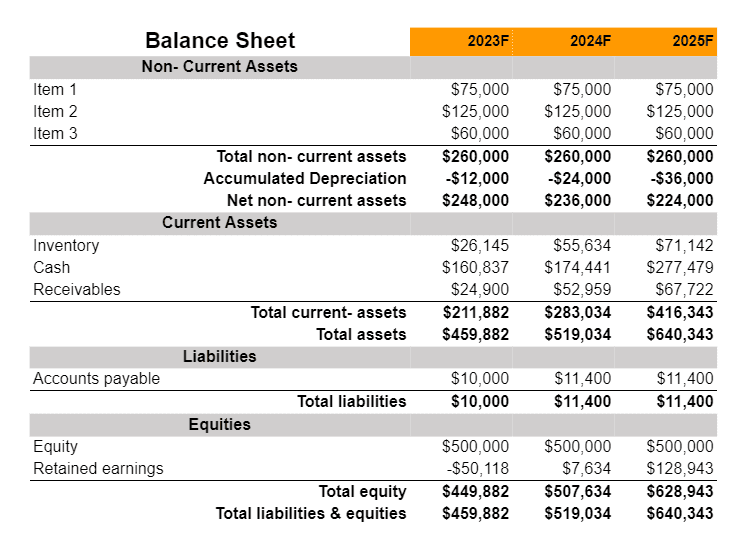
Revenue Summary
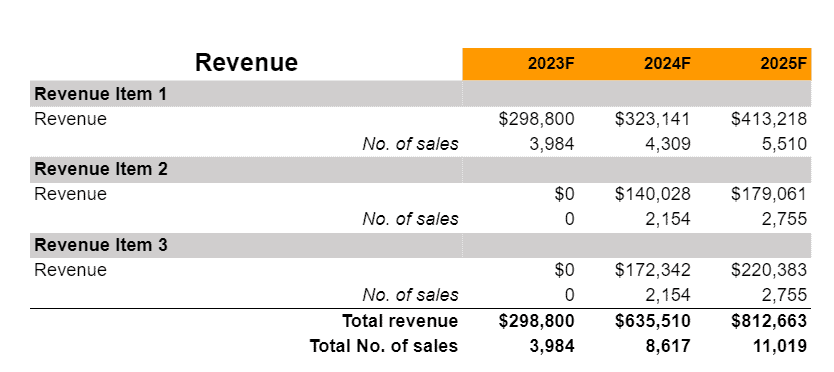
Cost of Goods Sold
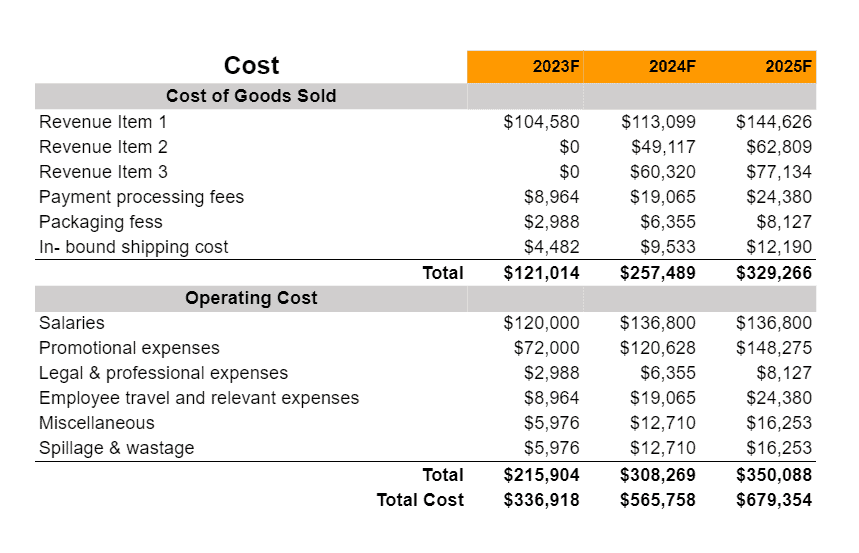
Related Articles on Business Plan:

